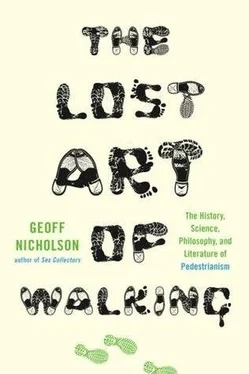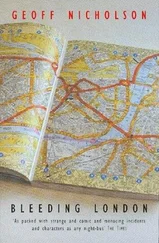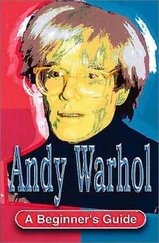Mudman made his first appearances in and around Los Angeles in the mid-1970 s, evolving out of a series of performances and installations, often in Venice Beach, where Jones lived at the time. Over the years he has walked as part of art events in San Francisco, Chicago, London, Rome, Germany, and Switzerland. Sometimes his own feces have been added to the mud, and in Rome he didn’t use mud at all, preferring yogurt and cottage cheese.
Mudman’s most famous example of art walking, however, consists of two twelve-hour walks along the full length of Wilshire Boulevard, about eighteen miles from downtown to the ocean in Santa Monica. He did the first walk on January 28, 1976, which was his birthday, from sunrise to sunset — then a week later, on February 4, he did it again from sunset to sunrise. Along the way he had the kind of encounters you might expect; a gas station attendant who wouldn’t let him use the bathroom, a cop who told him to keep moving, and an old lady who asked him, ‘Does your mother know you’re doing this?’
The walking artist is no novelty. Britain has two of the greatest walking artists in Richard Long and Hamish Fulton, and although Jones knows their work, he says his own art is more influenced by the work of Eva Hesse, Vito Acconci, and Joseph Beuys. And yet, for all the mythic aura surrounding Mudman, some of his origins are firmly rooted in Jones’s autobiography. Between the ages of seven and ten he suffered from Perthes disease, one of nature’s more savage little jokes, a condition that affects only children, restricting blood supply to the ball-and-socket joint at the top of the femur and causing the thigh bones to soften and break. It certainly puts a damper on any attempts to walk, and it’s not strictly curable, though it will pass of its own accord if the body is protected and allowed to heal itself. Bed rest, leg braces, and wheelchairs tend to be part of the process and Jones endured all of them.
Jones recovered in due course. One of his legs is still a little shorter than the other, he tells me, but that doesn’t stop him walking. Nor for that matter did it stop him enlisting as a marine in 1966 and going to Vietnam a year later. It’s not entirely clear whether Jones had a good or a bad war. We know that it involved doing a certain amount of walking, or at least marching, but his main job was delivering mail. Mudman looks like a combatant but also like a war victim, like one of the walking wounded.
I asked Jones if he had any plans to do a Mudman walk in the near future, hoping I might walk along with him, or at least observe other people’s reactions. ‘I still do Mudman’, he said. ‘I haven’t done it in a while, but I plan to do it as long as I can. My favorite time to do Mudman is when no one expects or knows that I’m going to do it’.
Of course if you’re in Los Angeles you could say that nobody ever expects anybody to do any walking at all, but the fact is, I now realize, that’s simply not true. The longer I live in L.A., the more I become aware that the city does indeed have a rich tradition of walking: political, literary, artistic, recreational.
There is an annual Cesar Chavez Walk, for example, at which you’re invited to ‘walk alongside Chavez family members, students, elected officials, celebrities, and community members.’ By walking you join ‘the call for social justice’. Who could be so churlish as to walk against social justice? When Angelenos wanted to protest against the war in Iraq, they closed Hollywood Boulevard, and thousands took to it on foot. When they want to demonstrate in favor of Latino immigration, as they increasingly do, then Wilshire becomes a pedestrian precinct.
There is a long short story by Jim Harrison called ‘Westward Ho’, in which a dubious Native American character known as Brown Dog attempts to cross the city on foot, from Cucamonga to Westwood, some forty-seven miles. Back home in Michigan, Brown Dog is known as a ‘walking fool’. There’s plenty of walking in the fiction of John Fante, and Charles Bukowski’s novels contain a lot more walking than you might expect, much of it done when the hero’s car has broken down.
There’s a man called Neil Hopper who runs the website walk inginla.com. It features austere, minimalist records of his walks around the city. A typical walk might be called ‘June 23, 2007 Bell Gardens, Pico Rivera, Montebello’ or ‘September 24, 2005 Normandie Ave, Venice Blvd’, and that will be all the ‘text’ he provides. It’s as inscrutable as any art piece by Richard Long. There’ll be a Google map showing his route, plus maybe half a dozen nondescript photographs showing, say, a liquor store, a stretch of freeway, a midcentury motel, a cool old car. Beyond that there will be no indication of why he walks or what he gets out of it. The fact that he doesn’t even attempt to articulate his obvious pleasure strikes me as oddly noble.
Despite everything, some of us Angelenos keep on walking. It seems fair enough to question the essential wisdom and sanity of certain L.A. walkers, but for some of us it’s not only a passion and a pleasure, it’s also a necessary activity that keeps us (more or less) sane. We would be a great deal crazier, and certainly more depressed, if we didn’t do it.
And so to return to the naysayers, to the likes of Jean Baudrillard and his assertion, ‘As soon as you start walking in Los Angeles you are a threat to public order, like a dog wandering in the road’, the fact is, it takes rather more than a bit of pedestrianism to disrupt the public order of L.A. As far as that goes, L.A. can pretty much handle a dog wandering in the road, too. Print the legend if you must, but don’t expect all us Angelenos to live it.
3. Eccentrics, Obsessives, Artists
Walks with Richard Long, Captain Barclay, et al.
Sidewalk’s for regular walkin’, not for fancy walkin’!
— JASPER (in The Simpsons, ‘Who Shot Mr. Burns?’)
Looked at a certain way, walking is the most ordinary, natural, ubiquitous activity. What could be more commonplace or lacking in eccentricity than the act of walking? And yet we live in a world where plenty of people find the idea of walking for pleasure, much less for philosophical, aesthetic, or deeply personal reasons, to be not just odd but downright incomprehensible.
In 2005 when Steve Vaught, a four-hundred-pound ex-marine, began his walk across America, from San Diego to New York, the media tended to treat him as a weight-loss enthusiastic. He did the walk, and he did lose weight, just over a hundred pounds in thirteen months, and he did get to appear on Oprah . But his weight loss wasn’t enough for some, and you could see their point: at three hundred pounds he wasn’t the very best advertisement for walking as a weight-loss strategy. Vaught insisted that weight loss was only part of the story. He was also walking ‘to regain his life’, he said, and by his own account he has. ‘I no longer manage business or pursue money beyond what I need’, he says. ‘I’ve given away all my material things and live life out of two or three carry bags, and I recommend it highly’.
Weight loss, at least, was identified as a ‘good reason’ for walking, if not exactly natural. Walking naked, however natural in one sense, is still regarded as deeply odd. The most famous naked walker of recent years is the Englishman Steve Gough. He describes himself as ‘body positive’ and claims that his extensive experience of walking naked in the world has given him a ‘connectedness’ with others. He has now twice walked naked from Land’s End to John o’ Groat’s, a traditional walking route, the longest distance between two points on the British mainland. He has spent a lot of time in court, and a certain amount of time in jail.
Читать дальше












